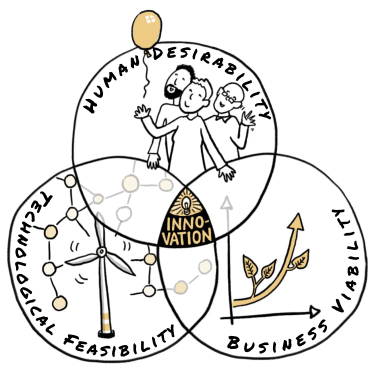Design Thinking Definition
Design thinking is an approach to develop new ideas and solve problems from the customer or user perspective. It is based on various methods that help interdisciplinary teams to understand the needs of customers and to solve the underlying problems. Creative prototypes make these concepts tangible. We introduce you to all the principles in detail in our Design Thinking Coach Course.
Design Thinking unfolds its effect on three levels:
Mindset, Skillset, Toolset
When organizations and teams use the Design Thinking approach, they move on these three levels. Methods (toolset) help to understand problems and develop solutions. However, participants need experience in collaborating and applying the methods (skillset). This internalization of the application of Design Thinking can influence attitude and mindset. Teams or organizations that think in a user-focused way, for example, have already incorporated the mindset.
Where did Design Thinking originate?
The Design Thinking approach goes back to David Kelly, Larry Leifer and Terry Winograd from Stanford University in the USA. They came up with the idea of using the creative way in which designers develop new products or services as an innovation method for other areas as well.
David Kelley comes from the design agency IDEO. As a product designer, he designed the first Apple mouse, among other things. From 2005 he developed the Design Thinking principles with Terry Winograd and Larry Leifer at d.school in Stanford. Students from all disciplines learned how to solve problems from all areas of life and business with a “designer’s mindset”.
Since 2007, the HPI School of Design Thinking in Potsdam has been spreading the approach in Germany and Europe.
With Design Thinking to Innovation
Design Thinking is a way of thinking about problems and solutions from the perspective of the people involved. Their needs are the focus here and the solutions developed should actually solve their problems in a meaningful way. But this is only one of three parts that are important for sustainable innovation:
Cross-functional thinking, after all, is the path to true innovation, according to the design thinking mindset. This basic assumption is represented by the graphic of the Venn diagram with its three intersecting circles: Innovation occurs at the intersection of desirability, feasibility, and viability.
Technological feasibility as well as economic viability, however, only gain their relevance once the need or human desirability has been identified, understood and taken into account. Otherwise, one runs the risk of developing past the market.
Design thinking is a human-centered approach to innovation that draws from the designer's toolbox to integrate people's needs, technology's capabilities, and business success requirements.
Tim Brown, CEO of IDEO Design Company Tweet
How does Design Thinking relate to Scrum?
Design Thinking and Scrum are two well-known approaches to dealing with complexity. Both approaches share the following fundamental aspects:
- Agile, sprint-based way of working
- Iterative, incremental process flow
- User-centeredness in the focus of the entire product/service development process
- Multidisciplinary, self-organized and autonomous teams
- Visual work – using sketching to make things more understandable
- Creative collaboration (co-creation) – stakeholder involvement
It is worth taking a look at the differences or strengths of each approach:
Design Thinking shows its power in the rather early phase of exploration. Namely, when it is a matter of fundamentally understanding the problem or task and developing initial ideas based on the user’s perspective. Basically, Design Thinking is very well suited for strategy development.
Scrum plays to its strengths in implementation and incremental development. Scrum’s roles, artifacts and processes help structure a self-organized team and lead it to results. It is very suitable for developing a marketable product from a prototype.
In principle, a combination of the two approaches lends itself to a particularly complex problem. For example, in a Design Thinking Sprint, customer needs could be identified, ideas developed and prototypes implemented. The same team would then switch to Scrum mode to incrementally develop the prototype into a marketable innovation.
Four principles of Design Thinking
Design thinking is not so much a method as a way of thinking about problems and solutions from the perspective of people involved. Four principles shape the design thinking approach.
Human being in the center
The solution of a problem starts with putting the need of the affected person in the foreground. A product, service, or utility that puts human feelings, needs, and desires on the back burner will struggle to create truly relevant and meaningful solutions for its users.
Ambiguity
Contradictions are unavoidable and part of human nature. In a complex world, Design Thinking helps to deal with existing contradictions by encouraging to get to the bottom of them instead of ignoring them.
Iteration
Change is known to be the only constant. Technology and society are constantly evolving. In order to respond to new insights, a product must therefore be continuously adapted and changed. As with other agile frameworks, Design Thinking adheres to the incremental approach.
Show don’t tell
Part of the Design Thinking approach is to make ideas tangible. To do this, we try to approach problems and possible solutions in a playful way. This also means building models that can be touched and thus make a thought tangible. In this way, aspects that may have previously been overlooked become visible.
Design Thinking Mindset
Design Thinking enables a team to quickly identify and explore a problem or market opportunity. This approach fosters collaboration with stakeholders through regular/incremental tuning and testing, and helps elevate collaboration to a team-oriented, creative, and solution-focused level.
To reap the benefits of Design Thinking, we believe it is critical that teams develop a Design Thinking mindset. This includes:
- discovering and trying out the unknown with curiosity
- to work experimentally and practically creating
- with a focus on the user perspective, which is often emphasized
- communicate with a high degree of empathy
By integrating the above-mentioned aspects of the design thinking mindset and an accompanying mindset change, a fundamental change in perspectives on the requirements of the projects can occur.
David Kelley, professor at Stanford’s d.school has summarized the design thinking mindset in “creative confidence”. That is, the creative confidence to find solutions to complex problems. So it’s not just about a team mindset, but also about each individual developing the confidence to be creative themselves, or to be able to be creative.
"Design thinking draws on the natural - and trainable - human ability to be intuitive, to recognize patterns, and to develop ideas that are both emotionally meaningful and functional."
Tom Kelley & David Kelley, Creative Confidence Tweet
However, diversity and the alignment of different perspectives also play an important role in the Design Thinking mindset. At best, the team has as diverse a background as possible. From gender, culture and age to department and profession, different perspectives enrich the project. For the mindset, openness and collaboration are considered important prerequisites. This is in contrast to the often prevailing lone wolf mentality and competitive thinking. Furthermore, a culture of error is needed, a space in which people can express themselves freely. This means that leadership is needed that promotes creative self-confidence.
Design Thinking Process
Further you will learn here, how the Design Thinking process breaks down into six stages.
Frequently asked questions about Design Thinking
Design Thinking is an excellent way to develop ideas. If you are at the beginning of a project, Design Thinking helps to quickly generate initial ideas based on customer needs. Then to test and iterate.
Teamwork is one of the central principles of working with Design Thinking. Different perspectives from different team members support the innovation process. At best, team members have a multidisciplinary and diverse background.
Design Thinking belongs to the family of agile frameworks. The key agile feature is sprint-based iteration of results. This means advancing prototypes in development loops to marketable solutions. Other common features are self-organized and multidisciplinary teams working with Design Thinking.
Design Thinking offers a process that helps teams generate ideas and develop them into solutions. The team works on a question in several steps. First, the needs of the users are discussed, then summarized to a synthesis and finally ideas are collected and tested with prototypes. Design thinking provides a roadmap that can turn ideas into innovations.
Three central methods in the design thinking process are interviews, brainstorming and prototyping. Qualitative interviews can be used to understand the customer’s need and to solve the underlying problems. Different brainstorming techniques (such as reverse brainstorming or “What would Steve Jobs do?”) are used to think up unconventional and relevant ideas together with team members. Prototyping is a way to make ideas (tangible) and tangible (for example, through Lego or cardboard models, videos or initial visualizations). By building a simplified version of an idea, it can be validated quickly and cost-effectively and tested directly with users.
Yes, definitely. Design Thinking originated with a multidisciplinary background and mindset, hence anyone with or without previous experience in any field can become a Design Thinker or Design Thinking Coach.
Neueste Blogposts

Es hapert schon an den Basics – warum agiles Arbeiten nicht nur eine Frage des Mindsets ist
Sylvius beobachtet bei vielen Unternehmen und Organisationen, die er berät, ein Problem, das sich über die Jahre hinweg konstant zeigt: Die einfachsten Rahmenbedingungen oder Praktiken

Jenseits von Meetings: Die echte Rolle des Scrum Masters
Licht ins Dunkel bringen: die oft missverstandene Rolle des Scrum Masters. Ich möchte ein weitverbreitetes Missverständnis über die Rolle des Scrum Masters aufklären. Viele denken,

Remote-Trainings gestalten – auch das lernen Sie bei uns
Scrum-Übungen in Break Out-Sessions, agile Kollaboration auf Miro, Planungs-Poker im Forum, Frontalunterricht zu systemischen Wechselwirkungen. Was? Wie? Wann? Womit? Fragen, die beim Aufsetzen von Workshops

